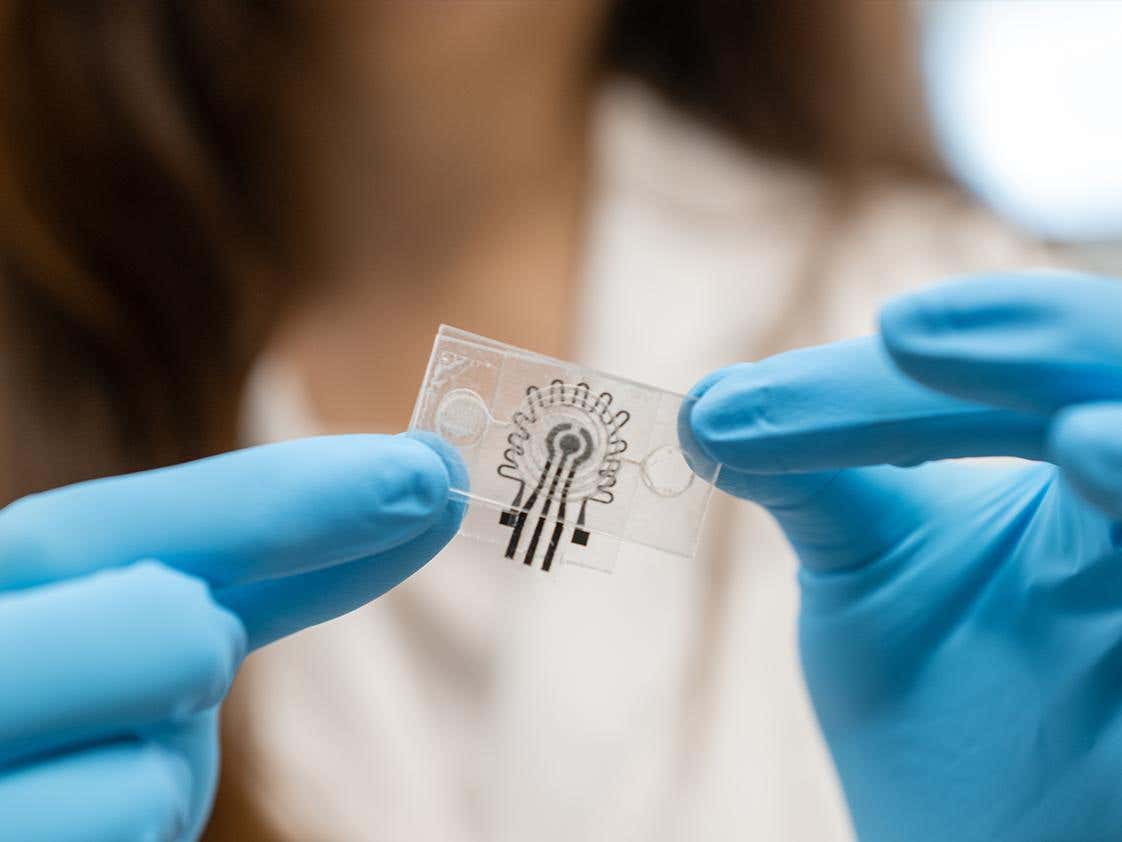Ultra-thin, wearable sensor reinvents wireless continuous glucose monitoring
Researchers developed wearable tech to monitor health indicators as unique as glucose levels, using sweat as their primary detection medium

[Oct. 1, 2023: Staff Writer, The Brighter Side of News]
Penn State researchers developed a new wearable sensor to monitor glucose levels in sweat over multiple weeks. (CREDIT: Kate Myers/Penn State)
Wearable technology, though not new, has now taken a quantum leap. Gone are the days when mere fitness metrics and heart rates were the crux of health monitoring.
Researchers at Penn State have evolved wearable tech to monitor health indicators as unique as glucose levels, using sweat as their primary detection medium. This research can redefine how we interact with our bodies, understanding health in real-time.
Sweat: A New Frontier in Health Monitoring
Sweat has long been recognized as a potential treasure trove of health data. "Sweat is ideal for real-time, continuous, and noninvasive biomarker detection," explained Huanyu "Larry" Cheng, principal investigator and the James L. Henderson, Jr. Memorial Associate Professor of Engineering Science and Mechanics (ESM) at Penn State.
Related Stories:
The human body releases sweat as a means of natural thermoregulation. But within this sweat are biomarkers that can provide a glimpse into the body's internal workings. Specifically, glucose levels. However, traditional wearable sensors were ill-equipped to handle continuous monitoring.
According to Cheng, the primary challenge wasn't just detecting glucose, but also factoring in the variability of pH, salinity, and temperature, which have historically compromised the accuracy of sweat biosensors. To enhance accuracy, one would need a device that could not only detect glucose levels but also continuously monitor body temperature and pH levels.
The Wearable Revolution: Introducing the Novel Patch
Enter the Penn State researchers' game-changing invention: a wearable patch designed with a laser-modified graphene nanocomposite material. This patch doesn't just fulfill the above criteria but remains active for an impressive three weeks, as detailed in the Advanced Functional Materials journal.
Schematic showing the design, structure, and application of the microfluidic non-enzymatic sweat analysis patch. (CREDIT: Advanced Functional Materials)
One of the significant breakthroughs came from the researchers’ knowledge about laser-induced graphene (LIG) electrodes. These electrodes, created in a single step with laser scribing, offered the flexibility, affordability, and simplicity essential for wearable tech. Though LIG electrodes faced issues with glucose sensitivity and surface area limitations, Cheng and his team saw their potential.
By working on a nanoscale, the researchers achieved a massive milestone. They successfully created a stable 3D network of noble metal alloys, specifically gold and silver, and carbon-based nanocomposite materials, on the porous LIG electrode. Noble metals, given their high conductivity and resistance to oxidation, provided the perfect base material.
Modification of nanocomposite-LIG electrode glucose sensor before laser treatment. Schematics showing the three-electrode electrochemical sensor based on laser-induced graphene (LIG) nanocomposite. (CREDIT: Advanced Functional Materials)
The role of laser technology was integral. Cheng explained, "By heating the gold and silver alloy nanocomposite material with a simple laser treatment, the material also resists agglomeration." Agglomeration is the phenomenon where nanoparticles combine into clusters, thereby limiting the material's surface area.
Farnaz Lorestani, ESM postdoctoral scholar and first author of the study, shed light on how glucose detection works with this modified electrode. "Glucose on the surface of the modified LIG electrode oxidizes at lower potential," she stated. This oxidation causes a measurable change in current or potential that directly correlates to the glucose concentration in the solution.
Characterization of laser-treated LIG nanocomposite. A) Schematic showing drop-casting of the AgNRs/AuNPs-GO-CNT nanocomposite on the LIG WE (left) and effect of laser treatment to create the Ag/AuNPs-rGO-CNT nanocomposite (right). (CREDIT: Advanced Functional Materials)
The modified LIG electrode wasn't just limited to glucose. The research also highlighted its responsiveness to changes in pH levels. The researchers ingeniously combined the dual glucose and pH sensor with another LIG-based temperature sensor. This combination, merged with a stretchable layer embedded with coil-shaped microfluidic channels, allows the device to consistently collect and analyze sweat samples.
The Future of Wearable Tech
While the device's form factor is impressive – it's approximately twice the size of a postage stamp – its utility is truly groundbreaking. By being affixed to the skin using adhesive tape, the patch can wirelessly transmit all collected data to digital devices like computers and smartphones. This allows for real-time monitoring and analysis, giving users instant feedback on their health status.
Effect of the laser treatment on the Ag/AuNPs-rGO-CNT nanocomposite-modified biosensors. Comparison of the CV curves of the Ag/AuNPs-rGO-CNT nanocomposite-modified LIG WE before and after laser treatment. (CREDIT: Advanced Functional Materials)
Such innovation holds immense promise for the future. The capability of continuous sweat monitoring can be a game-changer in the fields of individual and population health, precision nutrition, and personalized medicine. Cheng's vision for the device is clear: "It is a low-cost platform offering convenient, accurate, and continual analysis of sweat in diverse conditions."
In essence, as technology converges with health, we stand at the precipice of an era where real-time health analytics becomes as commonplace as checking the time on a watch. Only this time, the watch doesn't just tell time; it provides a deep dive into the workings of our very biology.
For more science and technology stories check out our New Discoveries section at The Brighter Side of News.
Note: Materials provided above by the The Brighter Side of News. Content may be edited for style and length.
Like these kind of feel good stories? Get the Brighter Side of News' newsletter.



